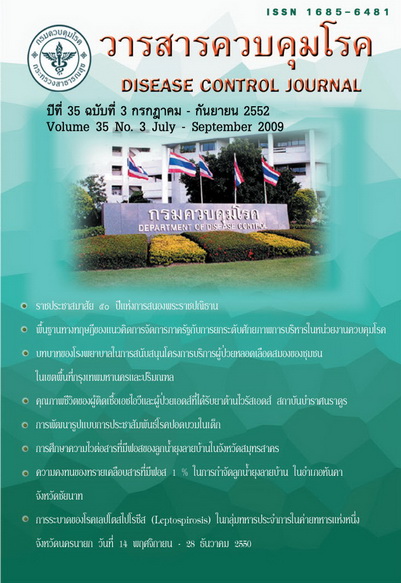Leptospirosis Outbreak at Military Camp in Nakhonnayok: 14 Nov-28 Dec 2007
Keywords:
Leptospirosis outbreak, Military camp, Nakonnayok,Abstract
On 27 Nov 2007, Bureau of Epidemiology (BOE) was notified from Nakonnayok provincial health office that there were 3 patients admitted at a military camp hospital suspected of having leptospirosis and one of them had died due to massive hemoptysis. BOE together with Nakonnayok SRRT, AFRIMS, DPC 3 performed the investigation on the same day in order to verify the diagnosis and also to investigate and describe epidemiological characteristic of the outbreak, source and risk factor and to recommend prevention and control measures. We reviewed medical record of suspected leptospirosis cases at the military camp hospital and performed active case finding by face to face interviewing of 255 out of totally 271 conscripts (94.09%). A retrospective cohort was performed among all conscripts with the same case definition as descriptive study except the dead case. It was found that 48 conscripts met the case definition (attack rate 18.8%) of descriptive study, with 37 symptomatic (77.08%) and 11 asymptomatic cases (22.9%). Median age was 21 years (range 21-29 years) and all of them were male. Main symptoms were fever, cough, sore throat, severe myalgia, chill and severe headache. Among them, 10 were admitted and 1 died. History of laying down on mud of Pond C during punishment on 13/11/2007 was significant risk factor (adjusted RR 2.72, 95%CI 1.53-4.82) while having wound before punishment at Pond C also increased risk (adjusted RR 1.63, 95%CI 0.97-2.73). Letospires were found by real time PCR (LipL32) from Pond C, Pond B and Canal A. The main serogroups of human cases were Australis and Icterohaemorrhagiae. From rodent data and rodents that trapped from nearby Pond C were positive for Leptospires by real time PCR (LipL32) but did not identify for serogroup. The result of blood and urine testing from cows at livestock area were all negative for Letospires. Strengthening the surveillance and proper education to military camp were implemented after the investigation.
Downloads
References
2. Judith Green-McKenzie, et al, Leptospirosis in Human; Http://www.emedicine.com
3. P. Cumerland., C.O.R. Everard and P.N. Levett. Assessment of the efficacy of an IgM ELISA and Microscopic Agglutination Test (MAT) in Diagnosis of Acute Leptospirosis. A J. Trop. Med. Hyg. 1999; 61(5): 731-734
4. Angela P. Brandao., Eide D. Camargo, Emilson D. DA Silva., et al. Microscopic Agglutination Test (MAT) For Rapid Diagnosis of Human Leptospirosis. Journal of Clinical Microbiology1998; 3138-3142
5. E. Hadad, A. Pirogovky, C. Bartal, J.Gilad, A. Barnea, S. Yitzhaki, et al. An outbreak of leptospirosis among Israeli troops near the Jordan River. A J. Trop. Med. Hyg. 2006; 74(1): 127-131
6. WHO 2003. Human leptospirosis: Guidance for Diagnosis, Surveillance and Control. International Leptospirosis Society.(cited December 2007); Available from: URL: http:/www.who.int
Downloads
Published
How to Cite
Issue
Section
License
Articles published in the Disease Control Journal are considered as academic work, research or analysis of the personal opinion of the authors, not the opinion of the Thailand Department of Disease Control or editorial team. The authors must be responsible for their articles.


.png)



